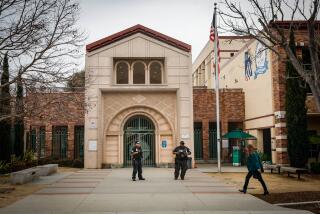School ID Cards List Hotlines
When high school students in Simi Valley register for classes this month and pick up school ID cards, they will be arming themselves with a little insurance in the event of a crisis.
Each card, which carries the student’s name and photo, will list on the back phone numbers and hotlines for a handful of local nonprofit organizations that deal with everything from drug and alcohol abuse to teen pregnancy.
It appears to be the first attempt by students in Ventura County to use school ID cards as a way to communicate with thousands of other teenagers.
The effort, led by the Simi Valley Youth Council, stems from the group’s 1999 study that showed nearly 50% of the 377 teenagers questioned used illegal drugs and were sexually active.
“The results we found were so compelling, and we saw there were people out there who wanted help,” said Christina Bobek, 17, who chaired the youth committee that organized the project. “Sometimes it’s hard to talk to a school nurse or counselor, and this way the information would be accessible 24 hours a day.”
Though the idea sounds simple, putting it together was not easy--particularly in one of Ventura County’s more politically conservative areas.
“We had to cut through so much red tape I could have wallpapered my room with it,” said Christina, who will be a senior this fall at Royal High School.
But the half a dozen teenagers who worked on the project persevered through wary school board members, jumpy parents and a chaotic trial run last year.
The students chose which organizations would be listed on the cards after poring through lists and calling each one, rating the groups in terms of accessibility and responsiveness, Christina said.
School board members at first were reluctant to approve the request because of concerns that the district would be endorsing one organization or intruding into sensitive areas that should be handled by parents, said board President Janice DiFatta.
Instead, trustees allowed the students to print the numbers on stickers that were supposed to be passed out to students last year on registration day. However, at one of the city’s three high schools, the stickers remained in an office all year, Christina said. At another, the cards had to be replaced because of a defective bar code.
“The information didn’t get to hardly as many kids as we had hoped,” she said.
Christina and others made speeches at school board and City Council meetings, in addition to writing letters.
This spring, both boards approved the plan and agreed to split the $900 cost of printing the extra information on the ID cards.
For Christina, picking up her student ID, a process that begins in two weeks, will certainly have more meaning.
“We were so excited that all of our endeavors had finally paid off,” she said. “Seeing the survey was an eye-opener, because we discovered there were problems that needed to be addressed and that people in the community didn’t even realize.”
More to Read
Sign up for Essential California
The most important California stories and recommendations in your inbox every morning.
You may occasionally receive promotional content from the Los Angeles Times.









